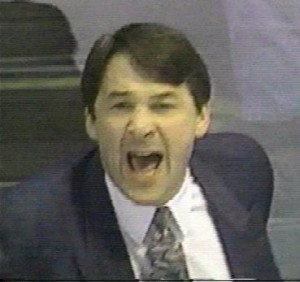I don’t know if it’s Todd Bertuzzi’s fault or what, but something is missing from hockey today. Maybe I’m too set in my ways, maybe it’s because my interest in hockey didn’t come from 90’s Era Expansion. It very well maybe that it’s because I’m living in Columbus, OH that I notice this. What’s missing – The inherent toughness that comes from playing hockey and being a hockey player. More over, learning it. I’ve noticed this in two different areas - youth league and beer leagues.
 |
| In case you're wondering who Chuck Norris prays to each night. |
In both instances, I blame the city in which I live. I’m going to start with Beer Leagues, especially the guys that learned to play as an adult (not to mention the roller hockey cross-over crowd) in this city. To those who learned to play as an adult: Toughen up. Beer league hockey is not non-contact, it is non-checking. You are required to wear full equipment for this reason. You are given a weapon and a means of transportation that will propel you faster than your feet ever will. The game is fast, powerful, and dangerous. You’re going to get bumped hard, you’re going to get tripped, you’re going to get hacked. I say this only once: watch what happens in the NHL on TV: 33.74 out of 35.58 body checks result in both participants skating away from each other. 99 out of 100 non-checking forms of contact in the NHL result in both players skating away from each other towards the play whether a penalty is called or not. Know what contact is allowed and what is not.
I understand the difference between getting bumped because a guy is trying to out-work me and a guy whacking me behind the knees just to be a douche. I know this because I played competitively growing up. You may have not played growing up because you lived in South Carolina, or your mom didn’t want you losing teeth, or there weren’t the funds in the household - whatever. As an adult, don’t whine like a little girl with a skinned knee of you get bumped off the puck. Don’t be a chatch to some guy who worked hard and made a physical play that took you off of your feet. It happens. However, be very cognizant of guys intentionally trying to hurt people or are unnecessarily physical and proceed with caution.
 |
| Happy Gilmore lays one on the Crypt Keeper. |
 |
| Proving that you don't have to have a good career to be a hockey troll. |
As a coach, you can't just tell a kid to be tough. You need to get to know the players and understand how each player listends. After a few weeks, you get to know the players. You know the kids that drop at the slightest contact, the kids that drop when they feel they’ve been wronged, and the kids that won’t tell you if a bone is sticking out of their skin. The first two are easy to deal with if a player goes down on the ice, but no matter what, I always assume the kids are hurt. After establishing these are crocodile tears and not a real injury, I tell the player (if applicable) I have to take them off the ice. 90% of the time the kids hop right up and skate to the bench and the tears of disappointment go away. They get a little pep talk from me and they’re ready to go next shift. Sometimes, the tears increase, which confirms tears of frustration. Tears of frustration are a little more sensitive to deal with but should positively be immediately addressed on the bench.
 |
| Not missing an opportunity to teach, the coach applauds the player for not getting hurt in the offensive zone. |
The manner in which you address the two types of crocodile tears is different, but the message is the same and positive. Clean physical contact is allowed and expected. To teach this, I encourage my skills coach to run ‘battle drills’ in practice just as much as we work on breakouts so that the boys are comfortable with contact. It’s a simple 2v2 small area game where the kids are encouraged to use body position to gain puck position and at any time can shoot the puck on net. This is of course after we teach allowable contact and how to skate into the boards during contact at a non-checking age. They become comfortable with contact in a game like situation, with players they know, in an environment where you can quickly address problems or demonstrate proper technique. This is a great example of how you teach kids to work hard, and by proxy, be tough.
 |
| Legal contact at all levels of hockey. |
As an adult, if you don’t know what contact is allowed and expected, our children will suffer, your beer league team will continue to stink, and women will shun you. Don't be a beer league chatch when someone beats you with the body because somewhere a 10 year-old is better at dealing with it than you.
 |
| Remember kids, no matter how far you make it in hockey, all drains lead to the Beer Leagues. |

No comments:
Post a Comment